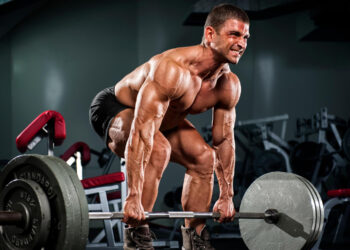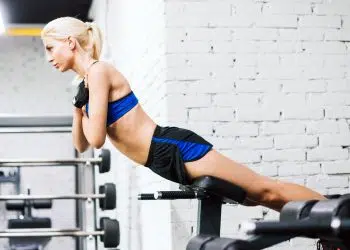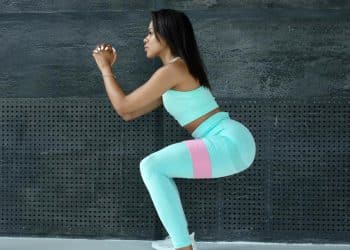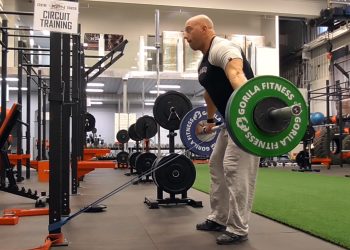If you had to choose one exercise to do for the rest of your life, you’d be hard-pressed to come up with anything better than deadlifts.
Conventional, hex bar, and sumo deadlifts work your lower body and upper body simultaneously, making them both functional and time-efficient. Whether you want to bulk up your back or strengthen your hamstrings and glutes, deadlifts are hard to beat.
But, while deadlifts are undeniably effective, that doesn’t mean you need to do them all the time. In fact, there are several variations you can use that’ll ensure your workouts are always interesting and productive.
Nordic deadlifts provide a novel way to work your posterior chain and could be the perfect exercise to breathe new life into your glute and hamstring workouts.
Nordic Deadlift – Muscles Worked
The Nordic deadlift is essentially a weighted hip hinge. As such, it’s technically an isolation exercise as the movement only occurs at one joint. But, despite this, the Nordic deadlift involves several muscle groups.
The main muscles involved in Nordic deadlift are:
Level Up Your Fitness: Join our 💪 strong community in Fitness Volt Newsletter. Get daily inspiration, expert-backed workouts, nutrition tips, the latest in strength sports, and the support you need to reach your goals. Subscribe for free!
Hamstrings – located on the back of your thighs, the hamstrings flex your knees and extend your hips. There are three hamstring muscles: biceps femoris, semimembranosus, and semitendinosus.
Gluteus maximus – known as the glutes for short, the glutes are the largest, most powerful muscle in the human body. Located on the back of your hips, the glutes work with your hamstrings to extend your hips. And yes, your glutes are your butt.
Erector spinae – the erector spinae is a group of muscles that run up either side of your spine. They’re responsible for spinal extension but, in Nordic deadlift, their main job is preventing your lumbar spine from flexing forward.
Core – the core is the collective name for the muscles of your midsection, including the rectus abdominis, obliques, transverse abdominis, pelvic floor, and diaphragm. These muscles contract inward like a weightlifting belt to create intra-abdominal pressure and support your lumbar spine from within.
Trapezius – your traps are located across your upper back. This large diamond-shaped muscle is made up of three sets of fibers: upper, middle, and lower. During Nordic deadlifts, the traps help stabilize your shoulder girdle, which is your scapulae and clavicles.
Rhomboids – located between your shoulder blades, the rhomboids work with your mid-traps to pull your shoulders back and together.
Forearms – Nordic deadlift involve your grip and, as such, work your forearms. Unless you use lifting straps, Nordic deadlifts can provide a useful forearm workout.
How to Do Nordic Deadlift
Get more from Nordic deadlift while keeping your risk of injury to a minimum by following these guidelines:
- Place a bench lengthways across the front of a Smith machine. Adjust the bar on the Smith machine, so it’s just above the height of the bench. Lock it in place. Put your barbell on the floor on the other side of the bench.
- Kneel on the bench with your feet and calves under the Smith machine bar.
- Lean forward and grab the barbell using an overhand or mixed grip. Brace your core and make sure your lumbar spine is slightly arched and not rounded.
- Contract your hamstrings and, without letting your hips move forward or backward, lift and raise your upper body until your torso is upright. Keep your arms straight and shoulders down and back throughout.
- Lower the barbell back to the floor and repeat.
- You can also do this exercise without weights, or using dumbbells.
You can also do this exercise kneeling back-to-front on a lat pulldown machine with your ankles hooked under the thigh restraint.
Nordic Deadlift Benefits
Not sure if the Nordic deadlift is the right exercise for you? Consider these benefits and then decide!
Variety – while conventional deadlifts, Romanian deadlifts, good mornings, etc., are all good exercises, if you do them too often, they may start to lose some of their effectiveness. Adding Nordic deadlifts to your exercise arsenal means you’ll have another move to add to your workouts, which could help keep you out of possible training ruts.
Movement progression – if you’ve mastered posterior chain exercises like Nordic hamstring curls and glute-ham raises, you will probably appreciate how the Nordic deadlift is even more challenging. Adding Nordic deadlifts to your workouts could help you take your posterior chain development to the next level.
Nordic Deadlift Drawbacks
While Nordic deadlifts are a mostly beneficial exercise, there are also a few drawbacks to consider:
Equipment – unlike conventional deadlifts, Nordic deadlift require more than just a barbell to do them. You’ll need a bench and a Smith machine or a lat pulldown machine. You may even need to come up with another way to do this exercise if you don’t have everything you need. As such, in terms of convenience, the Nordic deadlift may be too impractical for some lifters.
Too challenging for some exercisers – make no mistake, the Nordic deadlift is an intense exercise. Even with light weights, this move will challenge your glutes and hamstrings like no other. Beginners and even intermediate exercisers may find Nordic deadlift too challenging.
Risk of injury – the Nordic deadlift hits your hamstrings in a very unusual way. If your posterior chain workouts mainly involve regular deadlifts and leg curls, there is a definite risk of hamstring tears during this exercise. Use a light weight and limit your range of motion until you are confident that you’ll be able to do this exercise correctly.
8 Nordic Deadlift Variations and Alternatives
Nordic deadlifts are a highly effective posterior chain exercise, but that doesn’t mean you need to do them all the time. There are several variations and alternatives you can use to keep your workouts productive and interesting:
Level Up Your Fitness: Join our 💪 strong community in Fitness Volt Newsletter. Get daily inspiration, expert-backed workouts, nutrition tips, the latest in strength sports, and the support you need to reach your goals. Subscribe for free!
1. Nordic Hamstring Curl
The Nordic hamstring curl is the natural predecessor of the Nordic deadlift. It’s a bodyweight exercise that uses a very similar movement pattern. If you lack the equipment necessary to do Nordic deadlift, or they’re too challenging for you right now, the Nordic hamstring curl could be a viable alternative.
How to do it:
- Kneel on the floor and anchor your feet. Use a spotter, a loaded barbell, or a Smith machine bar set at a low position. Pad your knees with a folded gym mat or towel. Your body and thighs should be upright, hips, knees, and shoulders aligned.
- Brace your core, engage your glutes and hamstrings, and raise your hands up to your chest, palms facing forward.
- Using your glutes and hamstrings as brakes, lower yourself down toward the floor while trying not to bend at the hips. Use your arms to control your descent if necessary.
- Pushing off the floor with your arms if you need to, pull yourself back up to the starting position and repeat.
- You can make this exercise easier or harder by using bands, holding weights, or wearing a weighted vest.
Learn more about the Nordic hamstring curl in our in-depth guide.
2. Glute-Ham Developer (GHD) Raise
As its name implies, the GHD raise develops your glutes and hamstrings. As such, it’s an excellent alternative to Nordic curls. Usually done with just bodyweight for resistance, this exercise combines hamstring curls with back extensions to produce an intense posterior chain workout.
How to do it:
- Mount the machine and place your feet flat against the footplate. Rest your thighs on the leg pads. Use your arms to push your torso upright. Brace your core and cross your arms over your chest.
- Using your hamstrings and glutes to control your descent, lower your upper body down toward the floor. Stop when your torso is level with the floor.
- Bend your legs and pull yourself back up to vertical.
3. Barbell Hip Thrust
The Nordic deadlift may be too hard or simply impractical for some exercisers. After all, you need a lot of strength just to safely lift and lower your body weight. Barbell hip thrusts are considerably easier but still train the same muscles.
Another advantage of hip thrusts is that they are very easy on your lower back. If you want to work your glutes and hamstrings while avoiding stressing your lower back too much, hip thrusts are an excellent choice. Barbell hip thrusts are also a very accessible exercise that you can do in almost any gym.
How to do it:
- Sit on the floor with your legs straight and your upper back resting against a sturdy exercise bench or stability ball. Rest and hold a barbell across your hips.
- Bend your legs and place your feet flat on the floor. Brace your core.
- Drive your feet into the floor and lift your hips up until your body is roughly parallel to the floor.
- Lower your butt back down to the floor and repeat.
Learn more about this excellent exercise here.
4. Cable Pull-Through
If Nordic deadlifts are too complex or too demanding for you, you’ll probably be glad to hear that you can train your glutes and hamstrings equally well using nothing but a low cable machine and a rope handle. In fact, you can also do this exercise using a strong resistance band.
Cable pull-throughs are a straightforward exercise that, despite their simplicity, is still very effective.
How to do it:
- Attach a rope handle to a low pulley machine. Stand with your back to the weight stack, feet astride the handle.
- With your abs braced and shoulders down and back, bend down and grab the handle with both hands. Stand up and take a couple of steps forward to tension the cable.
- Stand with your feet shoulder-width apart, knees slightly bent, hands in front of your hips. This is your starting position.
- Push your hips back and lean forward until you feel a deep stretch in your hamstrings. Keep going until your hands travel behind your knees. Do not allow your back to round. Maintain a neutral spine throughout, including your upper back and neck.
- Drive your hips forward and stand back up, locking your knees and tensing your glutes as you reach the top of your rep.
- Hinge forward again and repeat.
Learn more about cable pull-throughs here.
5. Stability Ball Hip Lift and Leg Curl
This bodyweight exercise combines two movements into one to really hammer your hammies and glutes. There is very little stress on your lower back, which could be beneficial for some exercisers. It’s also a valuable exercise for anyone who trains at home.
How to do it:
- Lie on your back with your legs straight and feet resting on a stability ball. Place your hands on the floor by your side for balance.
- Push your heels into the ball to lift your butt off the floor, so your body is straight.
- Next, bend your legs and curl the ball in toward you. Push your hips up to the ceiling as you roll the ball in.
- Push the ball away so your legs are straight, and then lower your hips back down to the floor.
- That’s one rep – keep going!
- You can also do this exercise with your feet resting on sliding pads or a folded towel, although your range of motion will be somewhat smaller.
6. Snatch Grip Deadlift
Like the Nordic deadlift, the snatch grip deadlift is an effective glute and hamstring exercise. However, it’s instantly more recognizable as a deadlift variation and more convenient and accessible to do. After all, to do snatch grip deadlifts, all you need to do is move your hands further apart.
While this might seem like a small modification, a wider grip will significantly impact your performance of the deadlift and the muscles involved.
Read more about snatch grip deadlifts here.
7. Deficit Deadlift
Deficit deadlifts involve lifting a weight off the floor while standing on a raised platform. Doing deadlifts from a deficit increases your range of motion. In simple terms, you have to bend over more to grab the bar.
This means, compared to deadlifts from the floor, the weight travels further per rep. As well as increasing work and time under tension, deficit deadlifts increase glute and hamstring activation, which is what makes them a suitable alternative to Nordic deadlifts.
Learn more about deficit deadlifts in our in-depth guide.
8. Good Morning
The good morning is so-called because the movement looks a bit like you are bowing, as people used to do to greet one another. It’s a slightly controversial exercise because, if done incorrectly, it could cause injury. But that can be said about most exercises, so good mornings aren’t really all that different. Just make sure you use light to moderate weights and NEVER round your back when doing this exercise.
How to do it:
- Rest and hold a barbell across your upper back as though you are going to do a set of back squats. Make sure it’s on your fleshy traps and not on your neck. Hold it firmly in place with an overhand grip.
- Stand with your feet about hip-width apart, knees slightly bent. Brace your abs.
- Push your hips back and hinge forward, leaning over as far as possible without rounding your lower back.
- Stand back up again and repeat.
Read more about Good Mornings here.
Nordic Deadlift – Wrapping Up
The Nordic deadlift is a very challenging glute and hamstring exercise. You won’t see many people doing it, but don’t let that put you off. If you want to develop a strong and muscular posterior chain, the Nordic deadlift could be your secret weapon.
That said, this exercise is not the most convenient, and it may even be too hard for some exercisers, even if you use light weights.
So, if you are looking for a new way to train your glutes and hamstrings and already have a pretty strong posterior chain, this exercise could be just what you need to take your development and performance to the next level.
Interested in measuring your progress? Check out our strength standards for Good Morning, Snatch, Deadlift, and more.








